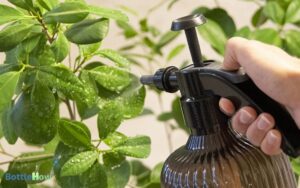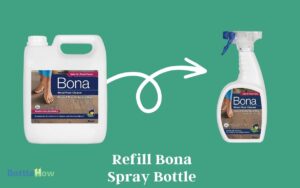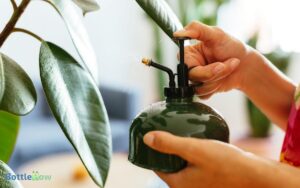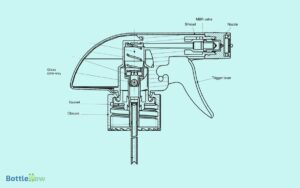Can You Put Acrylic Paint in a Spray Bottle? Yes!
Yes, you can put acrylic paint in a spray bottle, but you must thin it first to avoid clogging. Start by selecting a spray bottle made from HDPE or PET, equipped with an adjustable nozzle for consistent application.
Dilute the acrylic paint using water or a medium at a suitable ratio, ensuring the paint flows smoothly through the nozzle without losing too much pigment density.
Test the spray on a scrap piece and adjust the consistency as needed. Properly thinned paint will give you a fine mist and even coverage.
Learning how to prepare and maintain your setup will enhance your spraying experience.
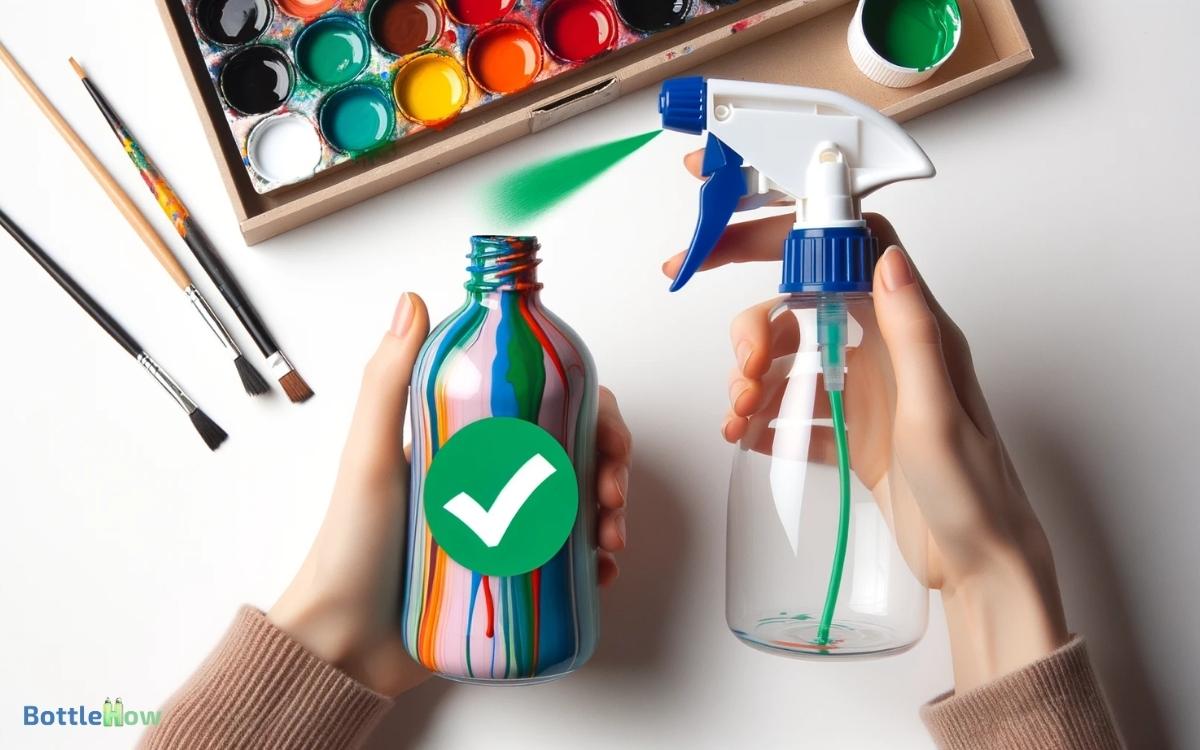
Key Takeaways
Understanding Acrylic Paint Properties
Understanding the properties of acrylic paint is vital as you prepare to transfer it into a spray bottle.
Acrylic paint is inherently thick and pigmented, designed for strong adherence and vibrant coverage on various surfaces.
Its fast-drying nature allows for quick layering but can pose challenges when used in spray bottles, as it may clog if not properly thinned.
You’ll need to adjust the paint’s viscosity; thinning it to a suitable consistency guarantees a smooth flow through the nozzle while maintaining the paint’s color integrity and opacity.
Remember, the dilution ratio greatly impacts the final outcome, influencing both texture and drying time.
It’s important to take these aspects into account to achieve the desired spraying effect without compromising the paint’s quality.
Choosing the Right Spray Bottle
When choosing a spray bottle for acrylic paint, you must consider the compatibility of the bottle material with the paint.
The right nozzle type is essential to guarantee a smooth and even spray, avoiding clogs and inconsistent application.
Selecting the appropriate materials and nozzle will enhance your painting project’s effectiveness and longevity.
Bottle Material Compatibility
Why should you carefully select the material of your spray bottle when using acrylic paint?
The choice impacts not only the durability and functionality of the bottle but also the consistency and quality of your paint application.
Acrylic paint is thicker and more abrasive than other mediums, so it requires a bottle made of resilient, chemical-resistant material.
Plastic bottles are generally preferable, particularly those made from high-density polyethylene (HDPE) or polyethylene terephthalate (PET).
These materials withstand the corrosive nature of acrylics and prevent the degradation of the bottle’s interior.
Additionally, make sure the bottle you choose doesn’t leach chemicals into the paint, which could alter its color and texture, ultimately affecting your project’s outcome.
Nozzle Type Selection
After selecting a durable spray bottle material, it’s vital to choose a nozzle that suits the unique properties of acrylic paint.
Here’s how you can select the perfect nozzle:
- Adjustable Nozzle: Look for nozzles that allow you to adjust the spray pattern from mist to stream. This flexibility will let you control the paint flow based on your project’s needs.
- Nozzle Size: Opt for a nozzle with a wider opening. Acrylic paint is thicker than water, so a larger nozzle helps prevent clogging and ensures a smoother spray.
- Material: Choose nozzles made from high-quality plastics or metals that can withstand the abrasive nature of acrylic paint.
- Test Before Use: Always test the nozzle with your paint mixture to confirm compatibility and performance, adjusting the paint consistency as necessary.
Preparing Acrylic Paint for Spraying
Before you start spraying, you’ll need to make sure you select suitable acrylic paint; not all types are appropriate for thinning and spraying.
You must thin your paint correctly using a suitable medium to achieve the right viscosity that won’t clog your spray bottle.
Always test the spray consistency on a scrap piece of material to guarantee smooth application and prevent wastage.
Selecting Suitable Acrylic Paint
To guarantee top performance when spraying, you’ll need to choose acrylic paint that’s specifically formulated for thinning.
Opt for high-quality, fluid acrylics designed for airbrush or spray application as they’ve smoother consistencies and are easier to manipulate without compromising the pigment’s integrity.
Here are some tips to help you select the most suitable acrylic paint:
- Check the Label: Look for terms like ‘fluid,’ ‘high flow,’ or ‘airbrush-ready’ which indicate suitability for spraying.
- Pigment Density: Choose paints with high pigment concentration for vibrant results.
- Brand Reputation: Prefer brands known for professional-grade materials.
- Opacity: Consider the opacity level you need, as it affects the number of coats required.
Choosing the right paint guarantees not only ease of use but also beautiful, lasting results.
Thinning Paint Correctly
Once you’ve selected the appropriate acrylic paint, you’ll need to thin it properly to guarantee a smooth, even spray application.
The key is finding the right balance; too thin and you’ll maintain color intensity and coverage, too thick and it may clog your spray bottle.
Start by adding a small amount of water or a professional acrylic medium to your paint. Stir it gently to avoid creating air bubbles.
Aim for a consistency similar to that of milk. This will secure the paint flows freely through the nozzle without sacrificing the paint’s vibrancy.
Testing Spray Consistency
After thinning your acrylic paint, verify its spray consistency to confirm it’s ready for application. Achieving the right consistency guarantees a smooth, even spray that won’t clog your bottle or result in a blotchy finish.
Here’s how you can test it:
- Pour a Small Amount: Start by pouring a small amount into the spray bottle.
- Test Spray: Aim at a scrap piece of paper or cardboard and spray. Look for even application without any clumping.
- Adjust if Needed: If the paint sprays unevenly or clogs, it’s too thick. Add more medium and mix thoroughly.
- Repeat: Continue testing and adjusting until you achieve a consistent, fine mist.
This method ensures your paint application is flawless and professional.
Step-by-Step Spraying Technique
Start by shaking your spray bottle vigorously to make sure the acrylic paint is thoroughly mixed. This guarantees an even consistency without any lumps that can clog the nozzle.
Next, you’ll want to test the spray on a scrap piece of material. Adjust your grip to maintain a steady pressure, aiming for a consistent spray pattern.
Keep the bottle at a consistent distance from the surface—about 6 to 8 inches—to avoid drips and achieve a smooth coat.
Here’s a quick guide to help you visualize the process:
| Step | Key Point |
|---|---|
| Preparation | Shake vigorously |
| Test Spraying | Use scrap material |
| Spraying | Hold 6-8 inches away |
| Technique | Maintain steady pressure |
Troubleshooting Common Issues
Encountering issues when using acrylic paint in a spray bottle can be frustrating, but most problems have straightforward solutions. Clogging is a common issue, often caused by paint that is too thick or not properly thinned with water or a suitable medium. To achieve a smooth application, especially when using spray paint for glass bottles, ensure that the paint is well-mixed and strain it before pouring it into the spray bottle. Additionally, regularly cleaning the nozzle can help prevent buildup and ensure an even spray pattern.
Here’s a list of common issues and how to tackle them effectively:
- Clogging: If the nozzle clogs, it’s likely due to thick paint. Dilute your acrylics with a bit more water or acrylic medium to guarantee a smoother flow.
- Uneven Spray: Shaky sprays often result from inconsistent paint consistency. Aim for a homogeneous mixture before filling the spray bottle.
- Weak Color Output: For more vibrant colors, increase the pigment concentration. Consider using higher-quality paints or adding a touch more colorant.
- Dripping: If paint drips from the nozzle, check for loose components and make sure everything is tightly secured.
Maintenance and Cleaning Tips
To keep your spray bottle in peak condition, regularly clean and maintain both the nozzle and the reservoir.
After each use, flush the nozzle with warm water to prevent clogging. If the paint has dried, soak the nozzle in a solution of warm water and mild detergent for a few hours, then use a soft brush to gently remove any residue.
Empty and rinse the reservoir thoroughly to eliminate any leftover paint, as this can affect future spray quality and functionality. It’s important to let all parts dry completely before reassembling.
Remember, diligent maintenance not only extends the life of your spray bottle but also ensures consistent, high-quality performance in your artistic endeavors.
Conclusion
Now that you’ve mastered the art of harnessing acrylic paint for spraying, you’re ready to release a universe of vibrant colors onto any canvas!
Remember, with the right spray bottle and a touch of preparation, you can achieve flawless, misty effects that will make your artwork the envy of the stars.
Keep your tools clean and your technique sharp, and you’ll be spraying like a pro in no time. Let your creativity flow boundlessly and color your world spectacularly!

